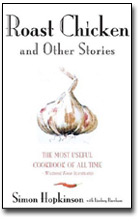Books |
Roast Chicken and Other Stories
Simon Hopkinson
By
Published: Jan 01, 2007
Category:
Food and Wine
Roast Chicken and Other Stories
Simon Hopkinson
“The most useful cookbook of all time.” That’s what Britain’s Waitrose Food Illustrated magazine said in 2005 about “Roast Chicken and Other Stories” after surveying English food writers, restaurateurs and chefs.
Simon Hopkinson’s triumph was something of a surprise. His book was thin: just 148 recipes. There wasn’t a single photograph of food in the book. And when it was first published in England in 1993, it hadn’t been a huge seller.
The award changed all that so dramatically that “Roast Chicken” started outselling “Harry Potter and the Half-Blood Prince” on Amazon.com’s English site. Now, fourteen years after Brits started cooking from it, “Roast Chicken” has finally been published in the United States. Talk about delayed gratification!
Why is this book so esteemed?
Hopkinson thinks he has a clue: “Without blowing my trumpet, I always knew it was a good book because it had nice things in it which you couldn’t help but want to eat. And as long as the recipes work, I knew it would be a useful book to have."
Your detective work need go no further than the clues in his response. “Nice things…you want to eat” — that means simple, familiar food, food that smells as good as it tastes. And “the recipes work” is a bottom-line explanation that, yes, if you follow directions, you can actually make these dishes more or less as well as Hopkinson.
Still, “useful” needs a bit of explanation — it means of use to the English. For that reason, there are many, many recipes in these pages that will have doubtful appeal to American cooks and eaters. Five recipes for…brains. Another five for…cod. Grouse. Hake. Kidneys. Rabbit. Haddock. Sweetbreads. Tripe.
What’s left? Start with Hopkinson’s amusing, contrarian and extremely helpful meditations on food that launch each section.
Like this: “Anchovies are best by far when accompanying meaty things.”
Or this: “Tuna is redundant in a salade Nicoise…I don’t think cooked tuna is anything to write home about.”
Or this: “The more boiling water you can have around a green vegetable, the greener the vegetable will stay.”
Or this: “When it comes to using tomatoes in sauces and stews, the canned Italian ones will do a much better job than most of the fresh varieties that are available to us.”
And then there’s the prose that reads like no other cookbook. Here is Hopkinson’s way of encouraging you to add potato cakes to your repertoire: “My mother makes really good potato cakes. They are sort of misshapen, soft, gooey, and floury. They are at their best eaten on a Sunday afternoon, melting in front of the fire in their pool of butter. It should be winter, about 5 PM, dark outside, and a Marx Brothers film has just finished on the television.” Makes me want to gather that recipe’s five ingredients — okay, so one of them is about eight tablespoons of butter — and get cooking.
Finally, there are the recipes that look, as the Brits say, brilliant: Asparagus soup, vichyssoise, roast chicken from Chez L’Ami Louis, chicken sauteed in vinegar, provencal scallops, steak au poivre (with “two good slugs” of Cognac), olive oil mashed potatoes, and lemon surprise pudding.
What recipe to feature? The roast chicken is the obvious choice. But Ami Louis uses a wood oven and gets chickens of a quality that Americans can only dream about. Better, I think, a recipe that shows Hopkinson’s strength as a conceptual thinker — say, one that moves beyond the usual combination of rosemary and garlic to deliver a totally delectable meal. That is….
Roast Leg of Lamb with Anchovy, Garlic and Rosemary
Serves 4
4-pound leg of lamb
2 2-ounce cans of anchovies
a small bunch of rosemary
4 large garlic cloves, peeled and sliced lengthways into 3 pieces
6 tablespoons butter, softened
black pepper
1/2 bottle white wine
juice of 1 lemon
a bunch of watercress, to garnish
Preheat the oven to 425 degrees. With a small sharp knife, make about 12 incisions 2 inches deep in the fleshy side of the leg. Insert a piece of garlic, half an anchovy and a small sprig of rosemary into each incision — push all of them right in with your little finger. Cream the butter with any remaining anchovies and smear it all over the surface of the meat. Grind over plenty of black pepper. Place the lamb in a roasting pan and pour the wine around. Tuck in any leftover sprigs of rosemary and pour over the lemon juice. Put in the oven and roast for 15 minutes.
Turn the oven temperature down to 350 degrees and roast the lamb for a further hour, or slightly more, depending on how well done you like your meat. Baste from time to time with the winy juices. Take the meat out of the oven and leave to rest in a warm place for at least 15 minutes before carving.
Taste the juices and see if any salt is necessary — it shouldn’t be, because of the anchovies. During roasting, the wine should have reduced and mingled with the meat juices and anchovy butter to make a delicious gravy. If it’s too thin, a quick bubble on the stove should improve the consistency.
Mashed potatoes are good with this, Hopkinson suggests. But if you’re like me, a Hopkinson “suggestion” is more like a command. And, for once, literally following orders is nothing but smart.
To buy “Roast Chicken and Other Stories” from Amazon.com, click here.


